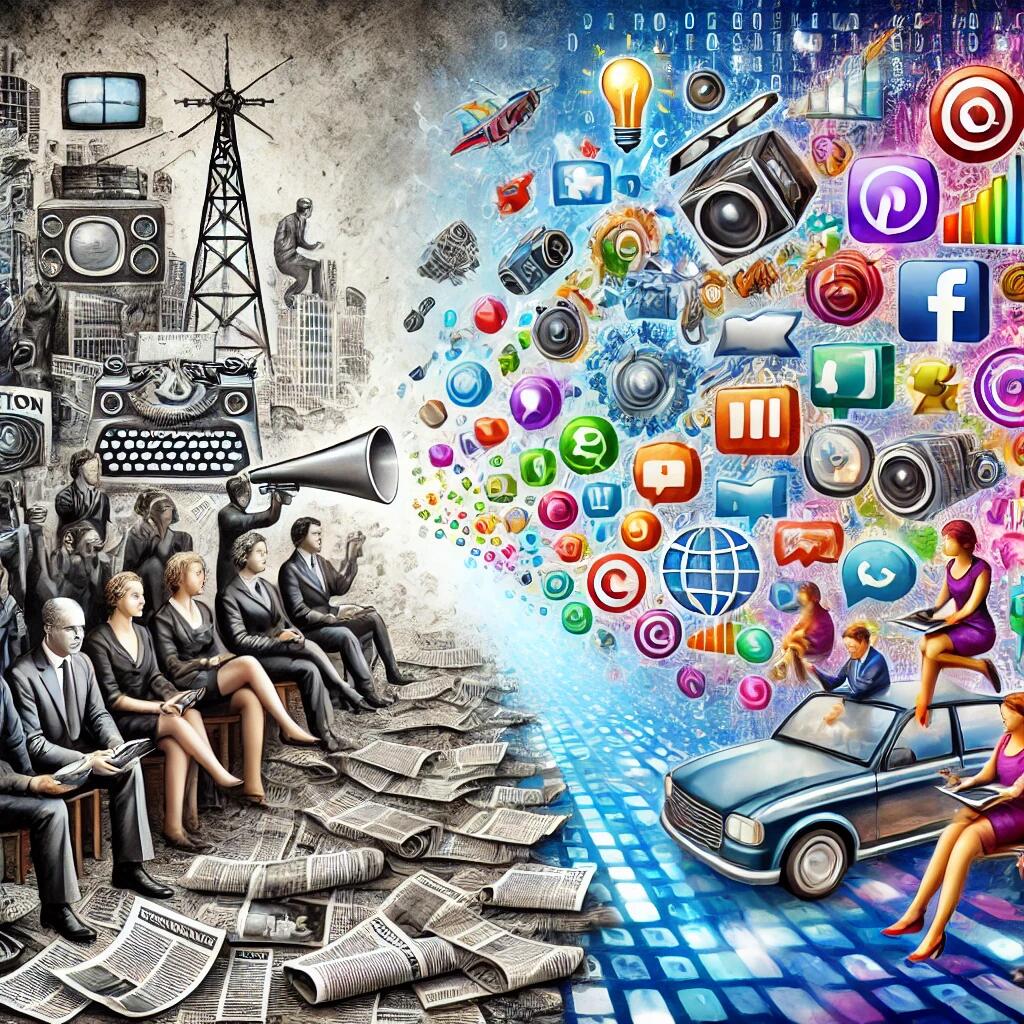SamuelGabrielSG on Nostr: The New Media: Consumers as Content Creators In recent years, we've witnessed a ...
The New Media: Consumers as Content Creators
In recent years, we've witnessed a seismic shift in the way news and information are consumed and created. Legacy media, once the dominant force in shaping public opinion, is now facing a serious crisis of credibility. The seeds of its own demise were sown through decades of dishonesty, bias, and a growing disconnect with the general public. This erosion of trust has paved the way for a new era where the consumers of content have become the creators—ushering in what can be called "The New Media."
The Fall of Legacy Media
For decades, legacy media outlets—newspapers, television networks, and large publishing houses—held a monopoly on the distribution of news. They were the gatekeepers of information, deciding what the public should know and how it should be framed. However, as the years passed, these institutions began to lose their way. Sensationalism, political bias, and outright fabrications became more common, leading to a gradual erosion of public trust. The internet, with its vast capacity for information exchange, exposed the cracks in their facade.
This dishonesty didn't just lead to a decline in viewership and readership; it sowed the seeds for something much larger. People began to look for alternatives—sources that would give them the unfiltered truth, or at least a version of events that didn't seem so obviously manipulated. Enter social media.
The Rise of New Media
Social media platforms like Twitter, YouTube, and even newer entrants like Substack and Rumble have democratized the flow of information. Now, anyone with a smartphone and an internet connection can report on events as they happen, share their opinions, and engage in discussions that were once the sole domain of professional journalists. This shift has turned the average consumer into a content creator, a journalist in their own right, capable of reaching audiences of millions.
This new ecosystem is more dynamic, responsive, and, crucially, more honest. While legacy media is bogged down by corporate interests, political affiliations, and a need to maintain a certain narrative, the New Media thrives on diversity—not just in terms of skin color, gender, or background, but in ideas. This diversity of thought is what drives innovation and progress in society.
Legacy Media's Response: Censorship
Legacy media, aware of its waning influence, has not taken this transition lying down. Instead, it has turned to censorship, often lobbying social media platforms to control the narrative. This is not about maintaining journalistic standards or combating misinformation; it's about survival. By stifling the voices of millions of independent content creators, legacy media hopes to reclaim its lost influence.
But this strategy is ultimately doomed to fail. The sheer volume of content produced by everyday individuals—videos, blogs, tweets, and more—overwhelms any attempt to suppress it. The New Media is agile, it moves faster, and it has the ability to flood cyberspace with a multitude of perspectives. In contrast, legacy media, like the dinosaurs it resembles, is slow, lumbering, and increasingly irrelevant.
A New Era of Ideas
The true power of the New Media lies in its ability to bring fresh, diverse ideas to the forefront. It's no longer enough to have a newsroom filled with people who look different but think the same. What the world needs are new perspectives, new approaches, and new solutions to the problems we face. The New Media, powered by millions of individual voices, is uniquely positioned to deliver this.
As legacy media continues to decline, the New Media will only grow stronger. This is not just a change in how we consume content; it's a fundamental shift in who controls the narrative. The days of being spoon-fed a carefully curated version of events are over. The future belongs to those who create, share, and engage with content in real time—everyday people who are shaping the world one post, one video, and one tweet at a time.
In this new landscape, the role of the individual is paramount. No longer passive consumers, we are all active participants in the dissemination of information. This shift is not just inevitable; it's necessary for the continued progress of society. The legacy media's day is done, and the New Media, where consumers are the creators, is leading us into a brighter, more honest future.

In recent years, we've witnessed a seismic shift in the way news and information are consumed and created. Legacy media, once the dominant force in shaping public opinion, is now facing a serious crisis of credibility. The seeds of its own demise were sown through decades of dishonesty, bias, and a growing disconnect with the general public. This erosion of trust has paved the way for a new era where the consumers of content have become the creators—ushering in what can be called "The New Media."
The Fall of Legacy Media
For decades, legacy media outlets—newspapers, television networks, and large publishing houses—held a monopoly on the distribution of news. They were the gatekeepers of information, deciding what the public should know and how it should be framed. However, as the years passed, these institutions began to lose their way. Sensationalism, political bias, and outright fabrications became more common, leading to a gradual erosion of public trust. The internet, with its vast capacity for information exchange, exposed the cracks in their facade.
This dishonesty didn't just lead to a decline in viewership and readership; it sowed the seeds for something much larger. People began to look for alternatives—sources that would give them the unfiltered truth, or at least a version of events that didn't seem so obviously manipulated. Enter social media.
The Rise of New Media
Social media platforms like Twitter, YouTube, and even newer entrants like Substack and Rumble have democratized the flow of information. Now, anyone with a smartphone and an internet connection can report on events as they happen, share their opinions, and engage in discussions that were once the sole domain of professional journalists. This shift has turned the average consumer into a content creator, a journalist in their own right, capable of reaching audiences of millions.
This new ecosystem is more dynamic, responsive, and, crucially, more honest. While legacy media is bogged down by corporate interests, political affiliations, and a need to maintain a certain narrative, the New Media thrives on diversity—not just in terms of skin color, gender, or background, but in ideas. This diversity of thought is what drives innovation and progress in society.
Legacy Media's Response: Censorship
Legacy media, aware of its waning influence, has not taken this transition lying down. Instead, it has turned to censorship, often lobbying social media platforms to control the narrative. This is not about maintaining journalistic standards or combating misinformation; it's about survival. By stifling the voices of millions of independent content creators, legacy media hopes to reclaim its lost influence.
But this strategy is ultimately doomed to fail. The sheer volume of content produced by everyday individuals—videos, blogs, tweets, and more—overwhelms any attempt to suppress it. The New Media is agile, it moves faster, and it has the ability to flood cyberspace with a multitude of perspectives. In contrast, legacy media, like the dinosaurs it resembles, is slow, lumbering, and increasingly irrelevant.
A New Era of Ideas
The true power of the New Media lies in its ability to bring fresh, diverse ideas to the forefront. It's no longer enough to have a newsroom filled with people who look different but think the same. What the world needs are new perspectives, new approaches, and new solutions to the problems we face. The New Media, powered by millions of individual voices, is uniquely positioned to deliver this.
As legacy media continues to decline, the New Media will only grow stronger. This is not just a change in how we consume content; it's a fundamental shift in who controls the narrative. The days of being spoon-fed a carefully curated version of events are over. The future belongs to those who create, share, and engage with content in real time—everyday people who are shaping the world one post, one video, and one tweet at a time.
In this new landscape, the role of the individual is paramount. No longer passive consumers, we are all active participants in the dissemination of information. This shift is not just inevitable; it's necessary for the continued progress of society. The legacy media's day is done, and the New Media, where consumers are the creators, is leading us into a brighter, more honest future.

